Deer are among the most popular mammals in the world! They are beautiful, elegant creatures that inhabit worldwide forests and open areas. Some deer species are even brave enough to venture into towns (which isn’t an advantage, though!).
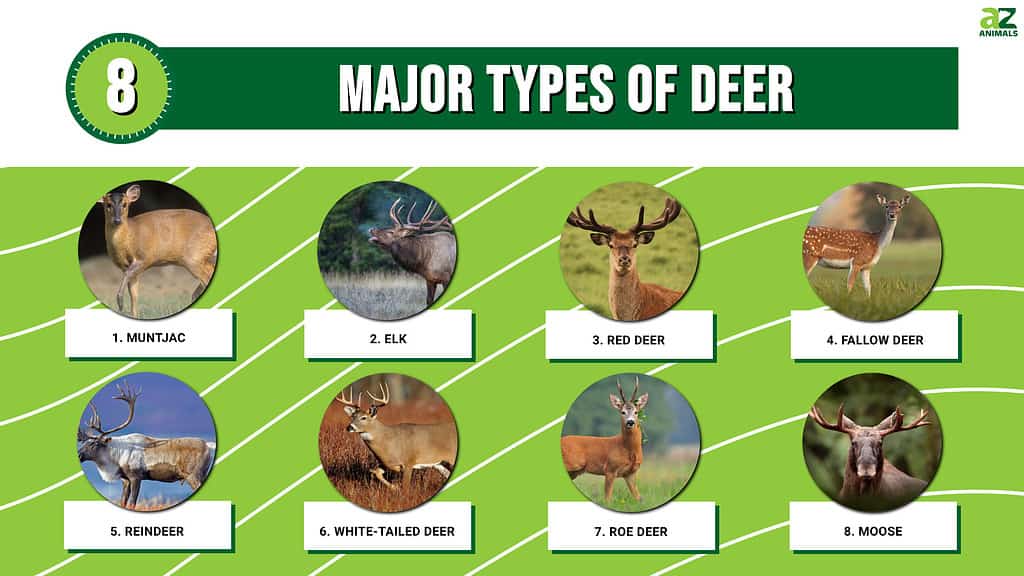
Their family is divided into two subfamilies, which, in turn, consist of several deer species and subspecies. We’ll first discuss each family and then move on to present eight major deer types. Enjoy!
The Cervinae Subfamily

The
Cervinaedeer subfamily is also called the Old World deer subfamily.
©iStock.com/Laurens Verhoeven
The Cervinae deer subfamily is also called the Old World deer subfamily. Some also call these deer plesiometacarpal deer, which points to the fact that they have only proximal lateral metacarpals.
This subfamily consists of eight genera, each with its deer species:
- Elaphodus genus – one species called tufted deer
- Muntiacus genus – 12 species, including the Indian muntjac and the Sumatran Muntjac
- Dama genus – two species, common fallow deer and Persian fallow deer
- Axis genus – four species, including the Indian hog deer
- Rucervus genus – two extant species, one extinct species
- Elaphurus genus – one species called Pere David’s deer
- Rusa genus – four species, including the Visayan spotted deer
- Cervus genus – five species, including elk and red deer
Besides these, this subfamily includes 14 extinct deer species.
The Capreolinae Subfamily

The
Capreolinaesubfamily is also called the New World deer subfamily.
©Slatan/Shutterstock.com
The Capreolinae subfamily is also called the New World deer subfamily or telemetacarpal deer group. The latter points to the fact that these deer maintain their distal lateral metacarpal.
This subfamily consists of 10 genera, which, in turn, consist of deer species:
- Capreolus genus – two species called western roe deer and eastern roe deer
- Hydropotes genus – one species called water deer
- Alces genus – one species called moose or Eurasian elk
- Rangifer genus – one species called caribou or reindeer
- Odocoileus genus – three extant species, including the white-tailed deer, and one extinct species
- Blastocerus genus – one species called marsh deer
- Hippocamelus genus – two species called taruca and south Andean deer
- Mazama genus – 23 species, including the gray brocket and the Brazilian brocket
- Ozotoceros genus – one species called Pampas deer
- Pudu genus – two species called northern pudu and southern pudu
There are also nine extinct genera in this subfamily.
8 Major Deer Species
Since the two subfamilies mentioned above consist of eight and nine genera, there are currently 17 major types of deer. However, we’ll only discuss eight of them – some of the most well-known and popular deer worldwide!
1. Muntjac
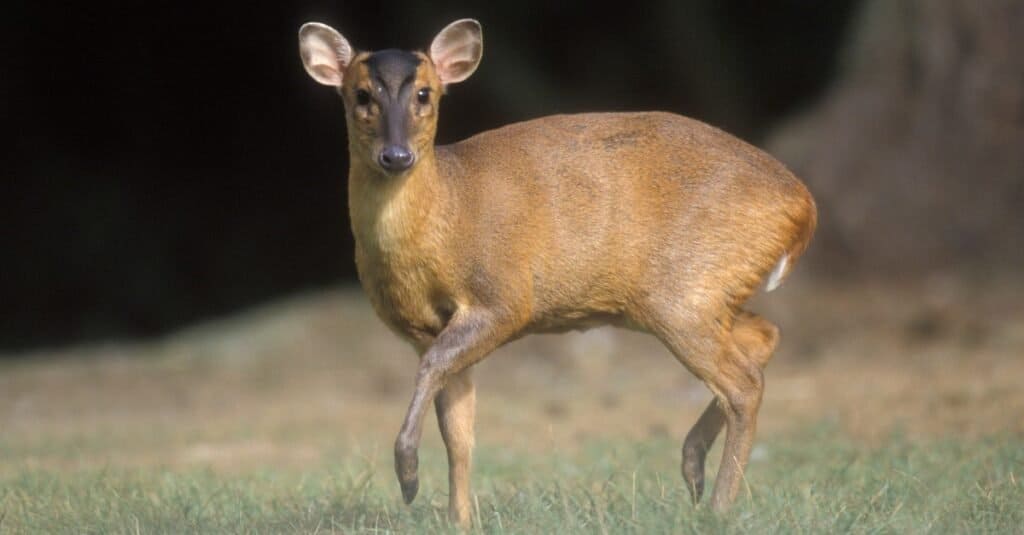
Muntjacs are native to South Asia and Southeast Asia.
©iStock.com/MikeLane45
| Muntjac | |
|---|---|
| Scientific name | Muntiacus |
| Scientific classification | Genus; the Cervinae subfamily |
| Common names | Muntjac, barking deer, rib-faced deer |
| Native to | South Asia and Southeast Asia |
| Conservation status | Most species are listed as Least Concern; some are listed as Vulnerable (black muntjac), Near Threatened (Bornean yellow muntjac), and Critically Endangered (giant muntjac) |
Muntjacs are the deer in the Muntiacus genus, which consists of 12 recognized species. These deer are native to South Asia and Southeast Asia and are believed to have inhabited the Earth for around 15-35 million years!
These deer live in India, Myanmar, Sri Lanka, Vietnam, Taiwan, Southern China, and the Indonesian islands. Reeves’s muntjacs are now found in the United Kingdom and Japan. Muntjacs can be found in rainforests, monsoon forests, and the lower Himalayas. Most deer live in habitats close to water sources.
The Indian Muntjac subspecies is unique because it’s the only mammal in the world with a diploid chromosome number of 6 in the female and 7 in the male.
2. Elk

Elk can grow as tall as 4 ft 11 inches at the shoulders.
©Ghost Bear/Shutterstock.com
| Elk | |
|---|---|
| Scientific name | Cervus canadensis |
| Scientific classification | Species; the Cervinae subfamily |
| Common names | Elk, wapiti |
| Native to | Central and eastern Asia, as well as North America |
| Conservation status | Least Concern |
The elk, also called wapiti, is one of North America’s largest terrestrial mammals. This deer species consists of 11 extant and two extinct subspecies.
These deer live in open deciduous forests, upland moors, boreal forests, grasslands, and mountainous areas. They can be found in central to eastern Asia and North America. Elk can grow as tall as 4 ft 11 inches at the shoulders and reach a nose-to-tail length of up to 8 ft 10 inches. Male elk are larger and heavier than females.
3. Red Deer
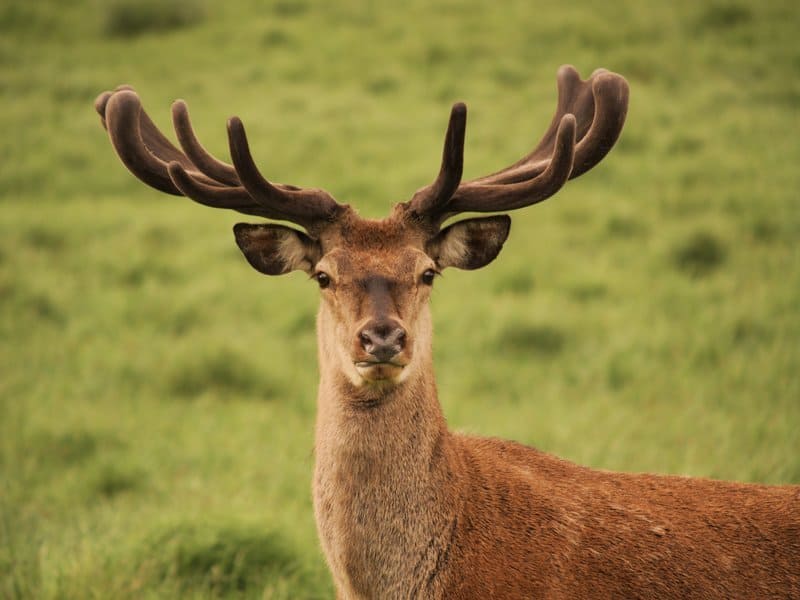
The largest red deer are in the Carpathian Mountains in Central Europe.
| Red Deer | |
|---|---|
| Scientific name | Cervus elaphus |
| Scientific classification | Species; the Cervinae subfamily |
| Common names | Male deer: stag or hart; female deer: hind |
| Distribution | Europe, western Asia, Anatolia, Iran |
| Conservation status | Least Concern |
The term “red deer” refers to the species Cervus elaphus, which in turn consists of about 13 subspecies. The previously mentioned American elk was once considered a red deer subspecies but was eventually established as a separate species.
These ruminants are the fourth-largest extant deer on Earth. Their size depends on their distribution. For example, the largest red deer are in the Carpathian Mountains in Central Europe. However, if we were to discuss an average, we’d say that male red deer grow up to approximately 98 inches long (without the tail) and weigh up to 530 pounds. Female red deer are smaller, reaching 83 inches long and weighing as much as 370 pounds. Their tails may add another 4 – 7 inches to the overall body length.
4. Fallow Deer

The fallow deer consists of two species: European fallow deer and Persian fallow deer.
©WildMedia/Shutterstock.com
| Fallow Deer | |
|---|---|
| Scientific name | Dama |
| Scientific classification | Genus; the Cervinae subfamily |
| Common names | Fallow deer, common fallow deer, European fallow deer, Persian fallow deer |
| Native to | European fallow deer: Turkey and possibly the Italian Peninsula, the Balkans, and the island of Rhodes; Persian fallow deer: all of the Middle East |
| Conservation status | European fallow deer: Least ConcernPersian fallow deer: Endangered |
The common name “fallow deer” is used for the Dama genus, which consists of two species: Dama dama (European fallow deer) and Dama mesopotamica (Persian fallow deer). The male European fallow deer grow approximately 55-63 inches long and 33-37 inches tall at the shoulders, while females are just slightly smaller, having a length of 51-59 inches and a height of 30-33 inches. In terms of weight, however, males are much heavier, reaching 220 pounds, while females rarely weigh more than 110 pounds.
Persian fallow deer can be found in tamarisk, pistachio, and oak woodlands. They are similar to European deer in appearance, except that they have less-palmated antlers.
Since 2008, Persian fallow deer have been listed as endangered on the IUCN Red List. Their conservation story dates way back, and many efforts have been made to protect their population.
5. Reindeer

Reindeer are the only group of deer that have females with antlers.
©Jeff McGraw/Shutterstock.com
| Reindeer | |
|---|---|
| Scientific name | Rangifer tarandus |
| Scientific classification | Species; the Capreolinae subfamily |
| Common names | Reindeer, caribou |
| Native to | Arctic, sub-Arctic, boreal, tundra, and mountainous regions of North America, Siberia, and northern Europe |
| Conservation status | Vulnerable |
Reindeer go by the name of caribou in North America. There are currently 14 recognized reindeer subspecies, and two are extinct. Reindeer are the only group of deer that have females with antlers. The color of the fur varies depending on the subspecies, location, and season. For example, northern deer are smaller and have light coats. Southern deer are larger and have darker coats.
These deer usually have a 64-81-inch length and a 180-260-pound weight. Male reindeer are larger than females. Another unique feature of reindeer is their vision. Studies show that reindeer can see light with wavelengths as short as 320 nm (as in the ultraviolet range), which helps them survive in the Arctic region.
6. White-Tailed Deer

White-tailed deer usually weigh between 150 and 300 pounds.
©Paul Tessier/Shutterstock.com
| White-tailed Deer | |
|---|---|
| Scientific name | Odocoileus virginianus |
| Scientific classification | Species; the Capreolinae subfamily |
| Common names | White-tailed deer, whitetail, Virginia deer |
| Native to | North America, Central America, South America |
| Conservation status | Least Concern |
The white-tailed deer is the most known and most common in North America. However, these deer have been introduced to other regions, such as New Zealand and Europe. They live east of the Rocky Mountains, southwestern Arizona, and Mexico in North America. Most white-tailed deer are located in Texas. More precisely, Texas hosts roughly 5.3 million deer!
The Odocoileus virginianus species is divided into 26 subspecies, and 17 can be found in North America.
These deer have a gray-brown coat during fall and winter and a reddish-brown coat during spring and summer. A whitetail’s most unique feature is its tail, which has a white underside. When it’s alarmed or feels threatened, it will raise its tail.
White-tailed deer usually weigh between 150 and 300 pounds, and males are larger than females.
7. Roe Deer
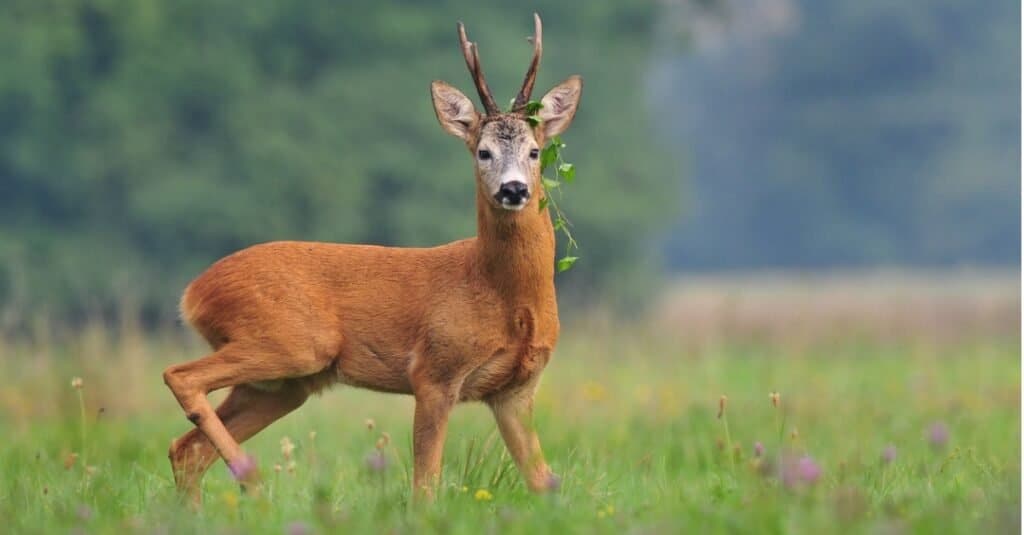
Roe deer prefer living above the tree line and in open agricultural areas.
©Soru Epotok/Shutterstock.com
| Roe Deer | |
|---|---|
| Scientific name | Capreolus capreolus |
| Scientific classification | Species; the Capreolinae subfamily |
| Common names | Roe, western roe, European roe; male roe deer: roebuck |
| Distribution | Europe |
| Conservation status | Least Concern |
Roe deer are a small species that can easily survive in cold and harsh environments, as their bodies have adapted to this kind of habitat. Moreover, they prefer living above the tree line and in open agricultural areas. However, if they look for food, they’ll search almost any habitat and then retreat to dense woodland to rest.
Most roe deer grow as large as 4 ft 5 inches long and 2 ft 2 inches tall at the shoulders. They usually weigh between 35 and 75 pounds. However, there’s a small exception: Kazakhstan roe deer are larger than most roe deer.
Buck antlers can reach 8-10 inches long and often have two or three points. Some unique bucks develop four points.
8. Moose
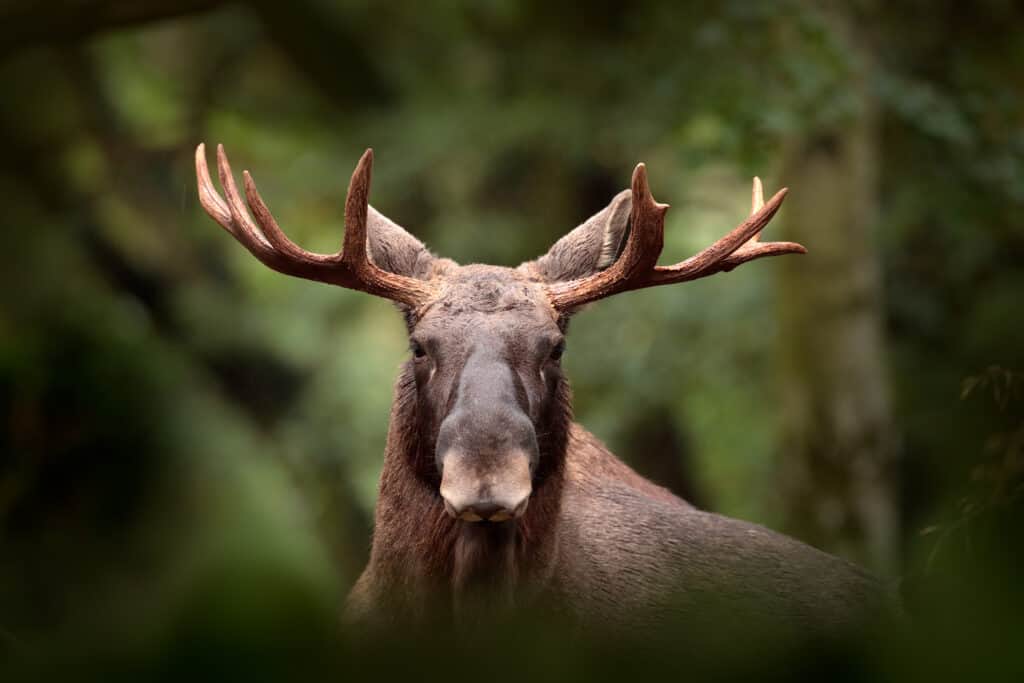
Moose live in the Northern Hemisphere’s broadleaf, mixed, and boreal forests.
©iStock.com/Ondrej Prosicky
| Moose | |
|---|---|
| Scientific name | Alces alces |
| Scientific classification | Species; the Capreolinae subfamily |
| Common names | Moose in North America and elk in Eurasia |
| Distribution | Alaska, Canada, New England, New York State, Baltic states, Kazakhstan, Poland, Russia |
| Conservation status | Least Concern |
The moose is the heaviest and the largest extant deer species. A moose’s most distinctive characteristic is its broad, palmate antlers. In contrast, other deer have twig-like antlers. They live in the Northern Hemisphere’s broadleaf, mixed, and boreal forests.
Moose have double-layered fur. They grow approximately 4.6 – 6.9 inches tall at the shoulders, so they are larger than elk (wapiti). Males weigh up to 1,543 pounds, while females aren’t as heavy, as they rarely reach more than 1,000 pounds.
Up Next:
- Deer Lifespan: How Long Do Deer Live?
- How Do Deer Stay Warm in the Winter?
- Florida Key Deer: Here’s What Makes Them So Special
The photo featured at the top of this post is © Martin Mecnarowski/Shutterstock.com
Sources
- Science, Available here: https://www.science.org/doi/abs/10.1126/science.168.3937.1364
- Wikipedia, Available here: https://en.wikipedia.org/wiki/Capreolinae
- Wikipedia, Available here: https://en.wikipedia.org/wiki/Cervinae
Thank you for reading! Have some feedback for us? Contact the AZ Animals editorial team.






